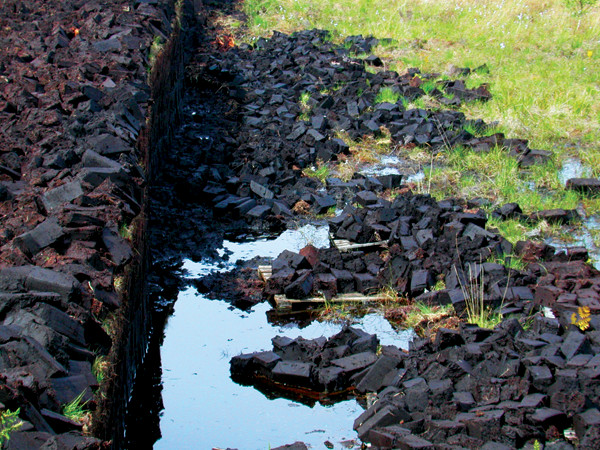
by U.S. Geological Survey Tuesday, July 29, 2014
Lori E. Apodaca, mineral commodity specialist for the U.S. Geological Survey, prepared the following information on peat, which is used primarily for horticulture in the U.S.

Although most peat is used in horticultural applications, it is still cut into blocks and used as fuel, as shown here at a peat bog in Ireland. Credit: ©markjhandel/CC-BY-2.0.
Peat is an organic material formed from the incomplete decomposition of plant matter under anaerobic conditions. Over thousands of years, layers accumulate at a rate of about 0.5 to 1 millimeter per year. Water sources and chemistry influence the type and decomposition of vegetation in peat ecosystems like bogs and fens, from which peat is harvested.
Bogs are acidic, fed only by precipitation, elevated above the surrounding landscape, have lower dissolved solids, and are less decomposed than fens. Fens are alkaline, fed primarily by groundwater, are situated in depressions that have a high water-level, and feature smaller peat depths than bogs. Peatlands are situated predominately in shallow wetlands in the Northern Hemisphere.
In the U.S. in 2013, peat was harvested and processed by 34 companies in 12 states. Florida and Minnesota accounted for more than 80 percent of total U.S. production. Reed-sedge was the dominant variety of peat harvested in the U.S., comprising approximately 78 percent of the total volume produced, followed by sphagnum peat.
Deposits of sphagnum peat in the U.S. occur in the northern states, with active recovery operations in Alaska, Maine, Michigan, Minnesota, Pennsylvania and Washington. Because of its more fibrous composition, sphagnum peat is preferred for custom soil mixes and for sale to retail consumers. Sphagnum peat also is used in filtration and as an absorbent. More decomposed peat, such as reed-sedge or humus, are used in bulk by commercial landscapers and on golf courses. About 90 percent of domestic peat is sold for horticultural use, including general soil improvement, golf courses, new construction, nurseries and potting soils.
More than 60 percent of all peat used in the U.S. was imported from Canada. In the short term, domestic imports from Canada are likely to continue to increase. Factors such as federal and state wetlands regulations, restrictions on permitting new production sites, and competition from organic soil amendments like coir (coconut fiber) and composted yard waste will likely reduce or slow growth in the domestic peat industry. Peatlands have been identified as carbon sinks, storing more carbon dioxide per unit hectare than any other ecosystem.
For more information on peat and other mineral resources, visit: minerals.usgs.gov/minerals.
In 2013, U.S. peat production was estimated to be 480,000 metric tons, excluding Alaska, and was valued at about $11 million.
Total world production was estimated to be 25 million metric tons, with Finland, Ireland, Belarus, Germany, Sweden, Russia, Latvia and Canada being the leading peat-producing countries.
U.S. apparent consumption of peat was estimated to be 1.4 million metric tons in 2013.
U.S. peat reserves are estimated at 150 million metric tons, compared with 12 billion metric tons worldwide.
Peatlands cover 3 percent of the world’s land surface. More than 90 percent of peatlands lie in the temperate and cold belt in the Northern Hemisphere, with Canada containing a quarter of all peatlands.
Peat is mainly used in horticultural applications as a soil amendment to add body to sandy soil, absorb and hold moisture and aerate plant roots by loosening heavy clay soils.
Peat has been used for energy for at least 2,000 years, including as an alternative to firewood for cooking and heating in temperate and boreal regions of Europe.
© 2008-2021. All rights reserved. Any copying, redistribution or retransmission of any of the contents of this service without the expressed written permission of the American Geosciences Institute is expressly prohibited. Click here for all copyright requests.